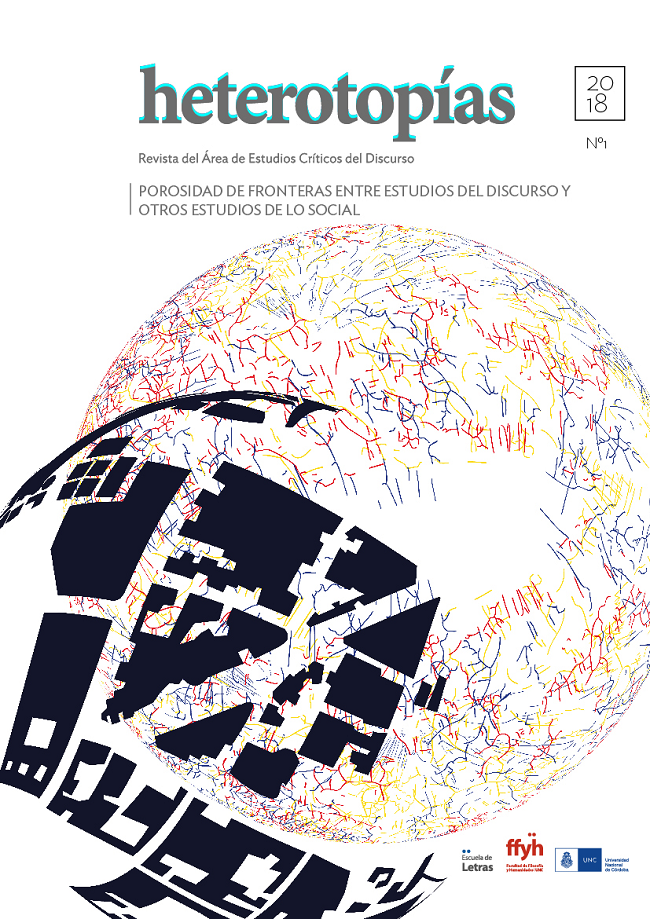Heterotopías: archivo y discurso
Main Article Content
Abstract
We propose a brief reflection that explores certain dimensions for an updated notion of archive based on the Foucaultian concept of heterotopia [1969]. While the archive works heterotopically contrary to the syntax of the ordered spaces of everyday life, it is at the same time a wonderful heterochrony that brings together a multiplicity of times and seems to be out of time. For Foucault, it constitutes a discursive space insofar as it is a historical a priori, a system that makes possible the emergence of a discursive field. It can be thought of as a social discursive device in the Veronian sense that, located beyond the plane of the language, documents a "spatio-temporal configuration of meaning" in any material support (things, images, words) that is the starting point of a multiple knowledge production. Transdiscursive territory that Foucault imagined and today challenges with new questions in the intangible territory of virtual archives.
Downloads
Article Details
Those authors who have publications with this journal, accept the following terms: Those authors who have publications with this journal, accept the following terms:
a. The authors will keep their copyright and guarantee to the journal the right of first publication of their work, which will be simultaneously subject to the Creative Commons Attribution - Non-Commercial - Share Alike (by-nc-sa) Attribution License; no commercial use of the original work or any derivative works is allowed, the distribution of which must be done with a license equal to the one that regulates the original work.
b. Authors may adopt other non-exclusive license agreements for the distribution of the published version of the work (e.g., deposit it in an institutional telematic archive or publish it in a monographic volume) provided that the initial publication in this journal is indicated.
c. Authors are allowed and recommended to disseminate their work through the Internet (e.g. in institutional telematic archives or on their website) before and during the submission process, which may lead to interesting exchanges and increase the number of citations of the published work. (See The effect of open access).
How to Cite
References
BAJTÍN, Mijaíl. (1982). “Hacia una metodología de las Ciencias Humanas”. En Estética de la creación verbal (pp. 381-396). México: Siglo XXI. (Versión original 1974).
DERRIDA, Jacques. (1997). Mal de archivo. Una impresión freudiana. Madrid: Trotta.
FOUCAULT, Michel. (2002). La arqueología del saber. Buenos Aires: Siglo XXI Editores Argentina. (Versión original 1969).
FOUCAULT, Michel. (2012). “Los espacios otros” en U-ABC. Archivo de lecturas y videos. Facultad de Artes de la Universidad Autónoma de Baja California. Recuperado de: http://tijuana-artes.blogspot.com.ar/2012/10/michel-foucault-los-espacios-otros.html. (Versión original 1967).
FOUCAULT, Michel. (2013). “Heterotopías y cuerpo utópico”. Recuperado de:
http://hipermedula.org/wp-content/uploads/2013/09/michel_foucault_heterotopias_y_cuerpo_utopico.pdf. (Versión original 1966).
GERBAUDO, Analía. (2012). “Archivos, Literatura y Políticas de la exhumación” Recuperado de: https://filologiaunlp.files.wordpress.com/2012/01/archivos-literatura-y-polc3adticas-de-la-exhumacic3b3n.pdf
VERÓN, Eliseo. (1993). La semiosis social. Fragmentos de una teoría de la discursividad. Barcelona: Gedisa.
VIGNA, Diego. (2017). “Imperativo del decir y au(di)toría automatizada en plataformas sociales online. Sobre cómo hacemos archivo compulsivamente”. Trabajo inédito destinado al libro en proyecto de edición: Arán, P. y Vigna, D. (comp.) Archivos, artes y medios. Entre la creación, la memoria y el poder.
ZEN, Daniel. (30 de septiembre de 2017). Entrevista a Emilio Perina: “El archivo es el lugar donde se cierra la grieta”, La Voz del Interior, Córdoba, p.8.
